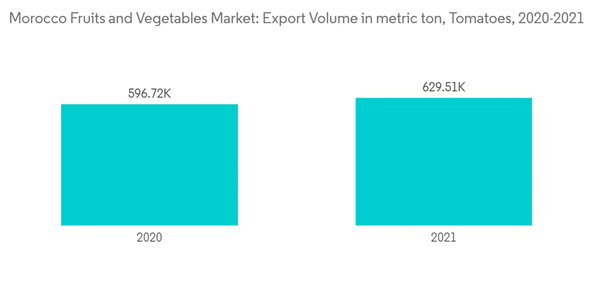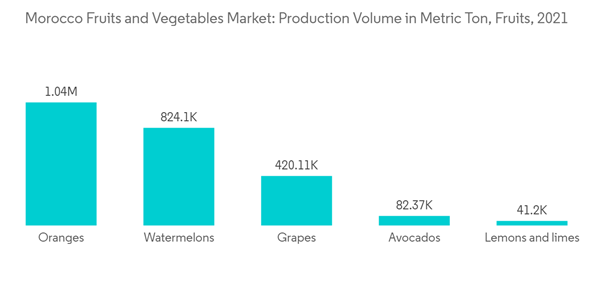Key Highlights
- The growing demand for fresh fruits and vegetables owing to an increase in consumer awareness of healthier alternatives, a growing economy, rising organic produce in the country, increased focus on fresh produce exports, and increasing fresh produce production from modern agriculture practices, including greenhouses and vertical farming, are some of the factors expected to drive the market growth over the forecast period.
- In Morocco, the consumption of healthier food is on the rise. More people in the country are shifting toward micronutrient-rich foods over animal-based diets. This change in dietary habits is attributed to the increasing health awareness in the country. Further, the rising incomes and growing economy are expected to significantly boost the demand for fresh fruits and vegetables in the near future. However, some factors, such as unfavorable and unpredictable weather conditions in the country and crop losses due to pests and diseases, are likely to restrain the market growth during the forecast period.
- Furthermore, Morocco's fruits and vegetable market is driven by government initiatives in the agri-food sector. Over the years, the food sector in Morocco has been experiencing steady growth. This can be attributed to the various initiatives undertaken by the government to promote the growth of the agri-food sector.
- For instance, in 2021, the government in the country planned to promote investment climate reforms in Morocco's agri-food sector. The initiative is focused on promoting sustainable investments in the agri-food sector. Many such initiatives are resulting in an increase in agricultural production in the country, which is driving the growth of the market.
Moroccan Fruits and Vegetables Market Trends
Increased Focus on Fresh Produce Exports
Over the years, the country has worked hard to retain its position as the global exporter of high-quality fresh fruits and vegetables. Fresh fruit exports have dramatically increased to 95% of all exported fresh goods. The country currently exports over 50 fruits and vegetables, including citrus fruits, tomatoes, green beans, zucchini, pumpkins, berries, etc. Citrus fruits and tomatoes lead in fresh produce exports, occupying the market's major share.According to the FAOSTAT, Morocco's tomato production increased from 13,470,85 metric tons in 2019 to 13,988,31.1 in 2020. This growth can be attributed largely to favorable production conditions and an increase in the hectares planted for tomatoes. Further, the European Union and Russia have remained the country's leading destinations of fresh produce exports. The country is planning to diversify its exports to supply countries in the Middle East and Africa. Therefore, with the increasing demand for fresh produce in the export market, the area under the fresh produce is expanding, which in turn is fuelling the growth of the market studied during the forecast period.
Orange Dominates the Fruits segment
The production of oranges takes place all over the country and is strongly related to weather conditions and market windows. The orange is the most planted fruit in Morocco, with approximately 60,525 hectares of area harvested and producing 10,393,82 metric tons in 2021, compared to other fruits, namely watermelons, grapes, avocados, blueberries, strawberries, and watermelon. Orange is a major fruit-producing commodity for Morocco, and the country's government has aimed various initiatives to improve fruit production. For instance, in 2020, the country's government Provided a $1,143/ha subsidy for creating new citrus, including orange plantations, using a drip irrigation technique.Moreover, the increase in production was brought about by adopting new technologies, effective use of agrochemicals, and favorable policies. In 2021, Morocco exported USD 67,644 Thousand to countries worldwide, as per ITC Trade Map. Further, domestic consumption of fresh oranges is growing as consumers demand freshly squeezed orange juice in their homes, bakeries, and restaurants. They also look for pasteurized juice produced at factories operating in the country. The domestic market for fresh oranges has become a major consumer of Morocco's total orange production. Thus, the local and regional demand is thus expected to drive the production of oranges in Morocco during the forecast period.
Moroccan Fruits and Vegetables Industry Overview
Additional Benefits:
- The market estimate (ME) sheet in Excel format
- 3 months of analyst support
This product will be delivered within 2 business days.










